With less than three months to go before the curtain falls on 2016, Sony’s KD-65ZD9 has catapulted itself as the frontrunner for our “TV of The Year” award. A general release towards the second half of 2016 gave the ZD9 (otherwise marketed as the Z9D in the USA) the opportunity to overtake rival TVs launched in spring/ summer when it came to raw specifications, and didn’t the Bravia television take full advantage.
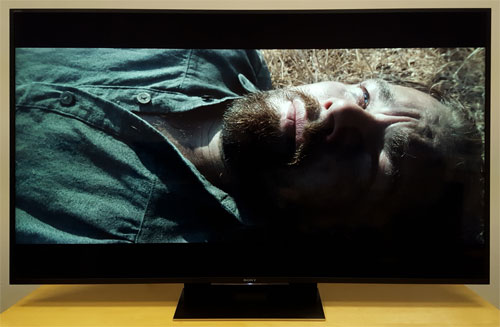
Blessed with the highest peak brightness and number of full-array local dimming (FALD) zones ever recorded on a consumer TV (at this time of publication), not to mention an excellent dimming algorithm that kept haloing/ blooming and luminance fluctuations to a minimum, the Sony 65ZD9 delivered by far the most glorious HDR (high dynamic range) images we’ve witnessed to date. And it’s no slouch at at SDR (standard dynamic range) either, as you shall see once we delve into the nitty-gritty later in this review.
The 65in Sony ZD9 we’re testing today is joined by the 75-inch KD-75ZD9 and the mammoth 100-inch KD-100ZD9. The Bravia KD65ZD9 retails at £3,999, which frankly is good value considering the outstanding performance on show.
Our Sony KD65ZD9BU review sample presented a few quirks for calibration. First, many of the settings including [Colour] and [Adv. colour temperature] are shared between SDR, HDR and 3D modes within the same picture preset on the same HDMI port. This means that if you use a single source player (for example the Panasonic UB900) to watch regular Blu-ray, 4K BD and 3D Blu-rays on the Z9D, you’d have to manually switch to different (calibrated) picture presets if you’d like to experience the best image quality from each format.
Also, on our review unit, the Basic [RGB Gain] and [Bias] values remained the same across different [Colour Temperature] settings within the same preset, preventing us from using [Colour Temperature] as a shortcut to apply separate day and night post-calibrated settings to other HDMI inputs on the KD-65ZD9.
Last but not least, the onboard 10-point white balance controls were displaced unless [Contrast] was decreased to a value that’s far too low. Fortunately, making adjustments using only the 2p white balance system was enough to attain accurate greyscale on the 65Z9D. Our calibration gear included a profiled Klein K10-A meter, DVDO’s AVLab TPG signal generator, and Spectracal’s CalMAN 2016 software.
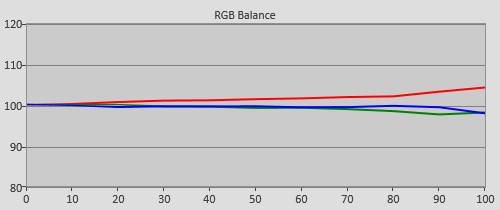 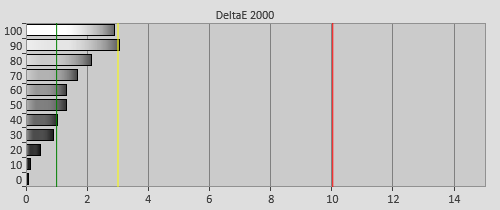 |
| Pre-calibration RGB tracking and delta errors (dEs) |
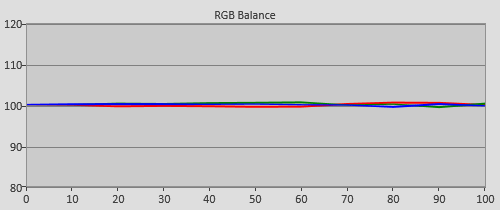 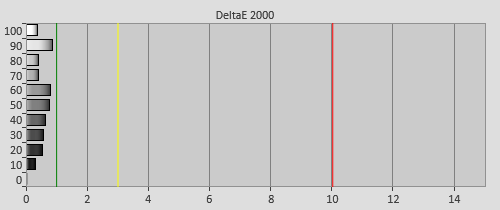 |
| Calibrated RGB tracking and dEs after 2-point white balance adjustments |
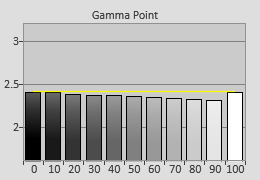 | 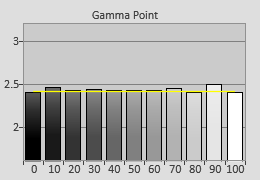 |
| Pre-calibration gamma tracking (2.35) | Post-calibration gamma tracking (2.44) |
This was probably the one rare occasion where we wished Sony had implemented a more advanced colour management system (CMS) on a Bravia TV beyond the basic [Colour] and [Hue] controls. As you can see from the CIE graph below, our 65-inch ZD9 sample painted most colours in a slightly oversaturated manner. Theoretically, lowering the global [Colour] setting could work to rectify the oversaturation, but unfortunately in practice, doing so also increased the colour luminance errors, making it a no-go.
Nevertheless, potential owners will be pleased to know that despite this mild oversaturation, only 1 out of 140 patches measured in the Colour Checker SG chart exceeded the humanly perceptible threshold of delta error (dE) 3. In other words, colours would mostly look accurate and realistic in real-world content.
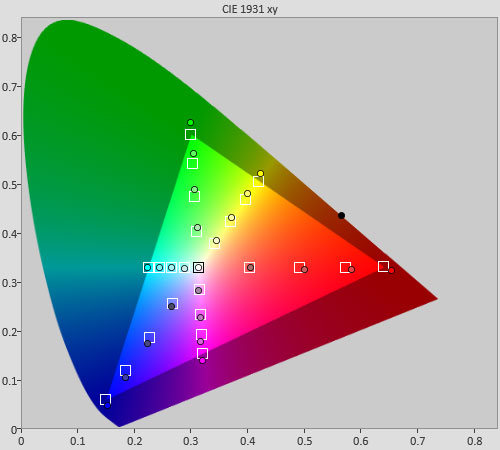 |
| Post-calibration colour saturation tracking |
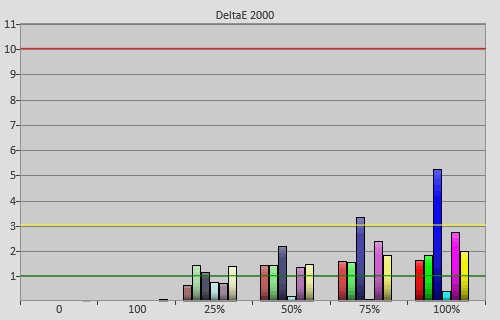 |
| Post-calibration colour errors (<3 not appreciable to the eye) |
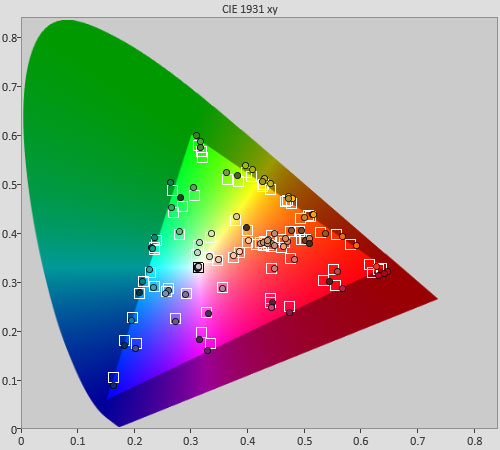 |
| Post-calibration Colour Checker SG test |
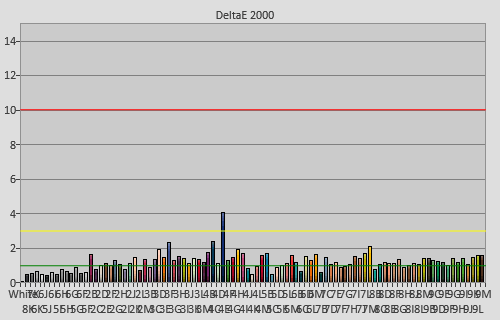 |
| Post-calibration Colour Checker SG errors (<3 not visible to the eye) |
| Dead pixels | None |
| Screen uniformity | Very good |
| Overscanning on HDMI | 0% if [Screen Format] “Full” & [Display Area] “Full Pixel” or “+1“ |
| Blacker than black | Passed |
| Calibrated black level (black screen) | LEDs dim down/ shut off |
| Calibrated black level (4×4 ANSI) | 0.029 cd/m2 with optimised [Auto Local Dimming] |
| Black level retention | Auto-dimming with full black screen |
| Primary chromaticity (Rec.709) | Slightly oversaturated |
| Scaling | Best we’ve seen on a consumer TV |
| Video mode deinterlacing | Decent for SD; excellent for HD |
| Film mode deinterlacing | Passed 3:2/480i & 2:2/576i with [Film Mode] engaged, though flickered with 3:2/1080i & 2:2/1080i |
| Viewing angle (cone) | 65° |
| Motion resolution | 1080 with [MotionFlow] “Clear” & “Custom“ |
| Digital noise reduction | Optional; effective when engaged |
| Sharpness | Defeatable edge enhancement |
| Luma/Chroma bandwidth (2D Blu-ray) | Full luma; chroma horizontally blurred except in [Game] & [Graphics] modes |
| 1080p/24 capability | No judder in 2D or 3D |
| 2160p/24 capability | No judder |
| Measured panel refresh rate | 120Hz |
| Measured peak brightness | 1870 cd/m2 (after calibration to D65) |
| Measured DCI-P3 coverage | 95% |
| Input lag (Leo Bodnar tester) | 42ms in [Game] & [Graphics] modes; 45ms in HDR |
| Full 4:4:4 reproduction (PC) | Yes for 3840×2160@60Hz with [HDMI Enhanced Signal] on |
| Default [Standard] mode* | 195 watts |
| Calibrated [Cinema pro] mode | 89 watts |
| HDR [Cinema pro] mode | 275 watts |
| Standby | <1 watt |
*Note: [Light Sensor] was engaged out of the box by default.
The VA-type LCD panel implemented on the Sony KD65ZD9 yielded the joint-deepest native black level (i.e. without the help of local dimming) we’ve measured from a Sony 4K television to date. After pegging peak white to our normal dark-room target of 120 cd/m2, our light meter recorded a figure of 0.048 cd/m2 from the central black patch on a 4×4 ANSI chequerboard pattern. On a full-field black raster, black level came in at 0.041 cd/m2 with [Auto local dimming] disabled.
| Macro photo of subpixel layout indicating VA-type LCD matrix |
Of course, no owner in his/ her right mind would spend this much money on a FALD LED LCD and not turn on local dimming. An optimised [Auto local dimming] setting would deepen blacks even further to 0.029 cd/m2 on a 4×4 ANSI chequerboard pattern, and pretty much unmeasurable on a full-field black raster since there were enough dimmable zones to shut off the LEDs at the centre of the screen.
Sony’s local dimming algorithm was so good, and the halos so well-controlled, that we were struggling to determine the exact number of independently dimmable zones. Using our own custom-authored test pattern containing a small white box crawling horizontally then vertically against the edges of a black screen, and after forcing HDR mode to exaggerate the haloing/ blooming, we counted 36 vertical columns and 18 horizontal rows, giving a total of 648 dimming zones. We’ll be the first to admit that this is only a guestimate, and the true number probably lies somewhere between 600 and 650.
To clarify once and for all, OLED – thanks to its self-emissive display characteristic – remains unrivalled in terms of black-level reproduction and intra-frame contrast. This was most apparent in starfield scenes: on the Sony 65Z9D, the stars looked dimmer (though still entirely visible) and the blacks slightly brighter when compared side-by-side against an LG OLED TV. Note that the following photos are included for the sole purpose of demonstrating the exact scenes described; please refrain from drawing conclusions from these photos since it’s impossible for our SDR camera to fully capture the actual difference visible in person.
 |
| The Martian Blu-ray opening scene. Left: LG OLED; Right: Sony Z9D |
Outside these challenging if infrequent examples, the Bravia KD-65ZD9 put up a credible fight against OLED in the black level department. Helped by 648-zone local dimming and exemplary halo suppression, the Sony managed to hold its own in this shot containing a bright logo surrounded by black backdrop:
 |
| The Martian Blu-ray (timecode: 00:00:47) |
Where the ZD9 edged ahead of the OLED was in the area just above black. As Sandra Bullock was hurling through space in Gravity, her silhouette appeared more distinct against the night sky, even if the LG OLED rendered the stars brighter and the blacks deeper. To reveal similar amounts of shadow detail, the LG’s [Brightness] and gamma would have to be adjusted to such an extent that the 0 cd/m2 blacks were ruined, or near-black artefacts were harshly exposed.
 |
| Gravity Blu-ray (timecode: 00:16:19) |
The Sony 65ZD9 also handled above-black region in a cleaner fashion than the LG OLED. In Skyfall (one of the best Blu-ray transfers of all time), the LG delivered the sequence where Raoul Silva (Javier Bardem) approached the chapel with more depth and dimensionality, but we could see the pixels dancing away in the night sky, whereas it looked more stable and less noisy on the Sony.
 |
| Skyfall Blu-ray (timecode: 02:09:45) |
The upscaling quality on 2015 and 2016 Sony Bravias has been good though never stellar, but the KD65ZD9 – featuring the Japanese maker’s new and improved X1 Extreme processor – is a totally different beast. According to our tests, the display boasts the best standard-def upconversion we’ve seen from a consumer-grade TV so far, outperforming even that delivered by the superb OPPO 103 Blu-ray player.
A 576i SMPTE RP-133 test card looked amazingly clean and sharp on the Sony ZD9, with no noticeable ringing, fizzing or junk pixels. Until today we’ve consistently rated Samsung as having the best in-TV scaling solution not necessarily because it’s the sharpest, but because it’s the most forgiving – our opinion may now change with the 65ZD9.
We’ve previously lamented the omission of [Smooth Gradation] from Sony’s 2015 and 2016 Android-based Bravia TVs, so imagine our delight when we discovered that this wonderful video processing feature has been reinstated on the KD65ZD9BU. For the uninitiated, [Smooth Gradation] is a useful option (we’ve only seen it offered on Sony televisions and projectors) to smooth out on-screen contouring by utilising the internal video processing’s higher bit depth. Here are the results when applied to an 8-bit gradient ramp from the AVSHD test disc:
Click on the options below to compare modes:
[Smooth Gradation] off | [Smooth Gradation] on

The Sony Bravia KD-65ZD9 was capable of delivering a motion resolution (as judged via the horizontally scrolling lines in Chapter 31 of the FPD Benchmark Software Blu-ray disc) of 1080 lines or even higher with [Motionflow] set to “Clear“, though this incurred a slight luminance drop (due to backlight scanning) and mild soap opera effect (SOE). This level of motion clarity could also be achieved by optimising the [Smoothness] and [Clearness] options under the [Motionflow] “Custom” submenu.
We found we didn’t need to push [Smoothness] and [Clearness] to as high as the values required on the Bravia X94C or XD94 to obtain 1080 motion resolution, underlining the ZD9’s superior motion processing. Just like [Motionflow] “Clear“, some soap opera effect (SOE) was unavoidable if [Motionflow] “Custom” was optimised to provide the sharpest motion, but it’s truly mild and acceptable – we’ve always found Sony’s film smoothing to be less offensive than other TV manufacturers’ anyway.
![[Motionflow] off](https://www.hdtvtest.co.uk/news/wp-content/uploads/2018/04/uhdtv_Sony-KD65ZD9_motionflow-off.jpg) | ![[Motionflow] Custom](https://www.hdtvtest.co.uk/news/wp-content/uploads/2018/04/uhdtv_Sony-KD65ZD9_motionflow-custom.jpg) |
| [Motionflow] “Off” | Optimsed [Motionflow] “Custom” |
In case it isn’t clear (pun intended), [Smoothness] and [Clearness] dictate the amount of motion-compensated frame interpolation (MCFI) and backlight scanning injected into the image respectively to boost motion clarity. Cranking [Clearness] to “Max” activates black frame insertion (BFI) but locks out the [Smoothness] control. While this resulted in supremely sharp motion without interpolation artefacts or soap opera effect, the picture became overly dim and flickery, making it unwatchable. Sony aficionados may remember experiencing the same outcome on older Bravia televisions with [Motionflow] set to “Impulse“.
Although we observed some black trailing/ smearing (where dark objects moving across a lighter background leave a visible trail) in torture test videos, we were hard-pressed to spot any in real-life viewing. However, if you’re sensitive to this type of motion smearing, Samsung’s quantum-dot-based SUHD TVs and certainly the LG OLEDs (what with their near-instantaneous pixel response time) will produce cleaner motion.
Once calibrated to D65 white point, the Sony KD-65ZD9’s peak brightness in HDR mode could be sustained above 1800 cd/m2 indefinitely (measured on UHDA-specified window sizes), peaking around 1870 cd/m2 at the start. This figure represents the highest we have on record at this time of writing, surpassing the peak luminance generated by the previous record holder, Samsung’s KS9500/ KS9800, by a magnitude of nearly 400 nits. Full-field peak brightness reached 745 cd/m2.
Taking a leaf out of Panasonic’s book (for the DX902/ DX900), HDR mode can be manually forced on through a new [Video options] submenu available on the Sony Z9D/ ZD9. To preserve the highest peak brightness, [X-tended Dynamic Range] should be left at its default value of “High“: peak luminance dropped to 1180 and 890 nits with [XDR] “Medium” and “Low” respectively.
As mentioned before, the KD65ZD9 carries over most picture settings from SDR to HDR mode within the same preset on the same HDMI input, with the notable exceptions of [Brightness] (which is bumped to “Max“) and [X-tended Dynamic Range] (which defaults to “High“). This situation is different from the step-down Sony XD93 and XD94 series which kick into a separate [HDR video] mode upon detection of the appropriate HDR metadata, thus allowing for separate SDR and HDR settings.
What this means is that to get the most accurate image, you either have to feed HDR material into one HDMI socket and SDR into another, or calibrate HDR in a separate picture preset from SDR (which requires manual switching every time you change sources from SDR to HDR and vice versa). For a seamless experience without needing to fiddle with the remote, we certainly prefer the Samsungs which allow for independent SDR and HDR settings within the same preset, or the LGs which go into dedicated HDR presets.
With this mini-rant out of the way, HDR mode on the Sony 65ZD9 actually calibrated very well. Greyscale could be flattened to a neutral D65 across the entire luminance range:
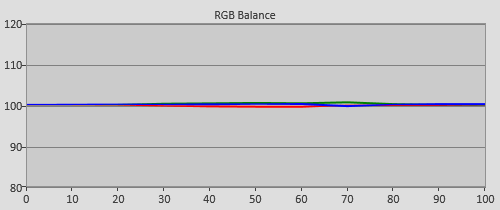
After adjusting [Gamma] to the correct value, the television tracked PQ (perceptual quantisation) EOTF (electro-optical transfer function) accurately until around 200 nits, after which light output was rendered slightly brighter that what’s stipulated by the ST.2084 standard:
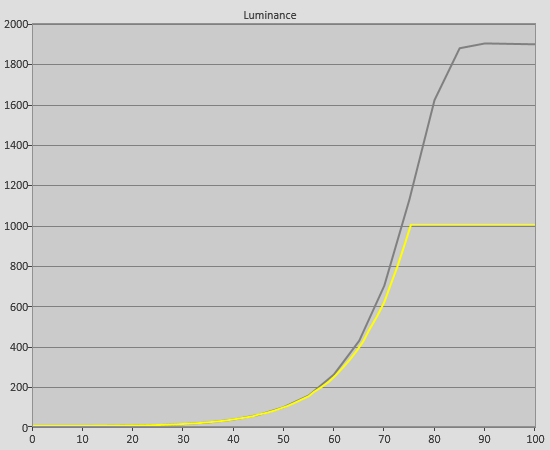
DCI-P3 coverage reached 95%, and colour tracking within Rec.2020 was reasonably good considering there’s no onboard CMS:
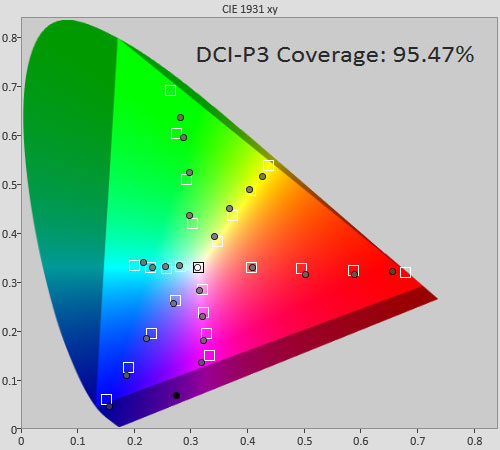
Having satisfied ourselves that our Sony KD65ZD9BU review unit had been calibrated to its best possible level in HDR mode, we watched our usual selection of 4K Blu-ray movies in a side-by-side comparison first against a 2016 LG OLED, and then against a Samsung Ultra HD Premium LED TV that we had in for review. Before detailing our observations, here’s a short primer.
What we’re about to write has seldom been explained, but one key reason why HDR video looks so impressive is the depth cues it’s able to provide. In real life, we judge depth and dimensionality through a number of ways, of which one is how light bounces off different surfaces. By supplying the headroom for specular highlights to be expressed in a more defined and accurate manner, HDR allows viewers to instinctively position different objects on screen based on the shape, intensity and directionality of the reflections, delivering a supremely immersive, 3D-esque image with tons of “pop” and depth.
Now, in theory OLED’s pixel-level illumination should give it an unassailable advantage in portraying specular highlights with the kind of precision even the best FALD LED LCDs with the highest number of zones can only dream of, but LG’s OLED televisions suffer from a few problems. First, peak brightness even on the 2016 flagship G6 couldn’t go beyond 800 nits, reducing the range through which subtle gradation of highlight detail can be faithfully rendered, especially when HDR content is mastered to 1000 or even 4000 nits.
Worse still, due to suboptimal tone-mapping (this is not entirely LG’s fault, since many Ultra HD Blu-ray discs are purposely encoded to defeat tone-mapping) and colour channel clipping, bright highlights would frequently get blown out on LG OLEDs. If a spot of well-defined reflection on a metallic object gets smeared out to a large shapeless area, it will distort the sense of depth you perceive from said object owing to loss of light directionality.
As you can already guess, the impact that the Sony KD-65ZD9’s 1800-nit brightness capacity bestowed upon HDR images was profound. Lightning struck with blistering brilliance; flames bristled with intensity; and chrome vehicle grilles glistened beautifully in Mad Max: Fury Road. Even during more mundane indoor scenes in The Martian, reflections off the eyes and shiny objects infused a very precise sense of depth and 3D-ness to the viewing experience.
We’d like to tip our hats off to Sony’s engineers for keeping haloing/ blooming artefacts fantastically under control (provided you sit mainly on-axis) in the face of such searing brightness. Of course the Z9D’s 600-plus FALD zones helped, but we’ve witnessed the Panasonic DX902 – whose number of dimmable zones wasn’t too far behind at 512 – exhibiting obvious rectangular grid-shaped halos in testing scenes containing bright objects against a dark background.
Without doubt, the local dimming algorithm on the Sony KD65ZD9 was superior to those implemented on its two chief FALD competitors when it came to HDR presentation. The Panasonic 65DX900’s was over-aggressive at times leading to blotchy darkening; while the Samsung KS9500’s was erratic, sometimes not engaging dimming when it’s called for. Sony’s local dimming system not only produced the inkiest blacks without crushing shadow detail, but also manifested the least blooming/ haloing. HDR output on the Bravia ZD9 also appeared remarkably free of posterisation (unless it’s in the source), something that cannot be said of Samsung’s 2016 KS lineup.
Back to Z9D vs LG OLED whose limited peak brightness and colour channel clipping also combined to strangle colour volume at the top end of the luminance scale. For example, during the Time Square sequence in The Amazing Spider-Man 2, Electro’s bolts of electricity carried a distinct blue hue on the Sony 65ZD9, whereas they were whitening out on the LG OLED. A similar difference was noticed in Mad Max: Fury Road where the Sony would render flames in fiery yellow; the LG OLED, muted orange.
Please note that the following photo was inserted merely to illustrate the TASM2 scene referenced, and is not representative of the true difference seen in person – OLED’s off-axis blue tint made the captured image look bluer than it actually was.
 |
| The Amazing Spider-Man 2 (timecode 00:53:29). Left: LG OLED; Right: Sony Z series |
Even though the Sony 65″ ZD9 had been judged to only resolve highlight detail up to 1500 nits in specialised test patterns, we actually saw very little – if any – loss of bright highlights in comparison with a Samsung UHD Premium TV deemed to be capable of resolving 4000 nits. Here are a couple of frameshots (photo exposure intentionally lowered to fully capture highlight detail) from Pan 4K Blu-ray which has been mastered to 4000 nits:
 |
| Pan (timecode 00:19:10). Left: Samsung SUHD TV; Right: Sony 65Z9D |
 |
| Pan (timecode 00:19:28) |
Shipping with two pairs of active-shutter glasses (ASG) included, the Sony KD65ZD9 put on an above average tri-dimensional performance. The Bravia TV passed full HD 3D resolution, and displayed 24Hz, 50Hz and 60Hz 3-D material (be it film- or video-based) without judder as long as the correct [Motionflow] setting was selected.
Crosstalk was faint and unobtrusive, and the stereoscopic image looked punchy enough with convincing layers of depth, but our main issue was increased flicker possibly caused by the screen’s higher luminance output… we even tried some third-party glasses which unfortunately didn’t improve things. Sensitivity to flicker is very individual, so your mileage may vary, but LG’s 4K OLED televisions deliver a better and less fatiguing extra-dimensional viewing experience.
The lowest lag times on the Sony ZD9 could be found in the [Game] and [Graphics] picture presets, measuring 42ms according to our Leo Bodnar tester. [Auto local dimming] had be disabled, or else input lag would go up a tad to 45ms.
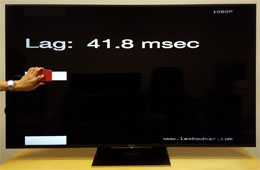 | 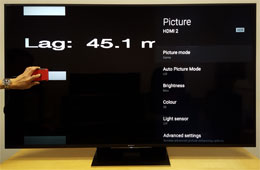 |
| Input lag in [Game] preset | Lag in HDR [Game] mode |
The Bravia KD-65ZD9 joins a growing number of 4K TVs which allow [Game] mode to be enabled for playing HDR games on the Xbox One S or the upcoming PS4 Pro. Since engaging [Auto local dimming] was necessary to hit the peak brightness demanded by HDR without washing out the blacks, input lag in HDR [Game] mode came in at 45ms.
We’ve been long-time admirers of Sony’s video processing particularly when it comes to local dimming algorithm and motion smoothness, and when record-breaking stats are added to the equation, the result is nothing less than spectacular. Some may complain that the Bravia ZD9’s peak brightness and FALD zone count fell far short of the 4000 nits and 1000 zones showcased on the company’s “Backlight Master Drive” prototype at CES, but Sony needed to make a domestic television that’s quasi-affordable for the masses, and in any case the KD-65ZD9 comfortably delivered the most mesmerising HDR presentation we’ve witnessed so far.
For HDR playback, the Sony Z9D/ ZD9 outperformed other 2016 top-tier FALD LED LCDs in the following ways. The TV featured more balanced local dimming and less haloing/ blooming than Panasonic’s DX900/ DX902; more effective dimming and less posterisation than Samsung’s KS9500/ KS9800; and a punchier picture with greater highlight detail resolution than Sony’s own already impressive XD94… the benefits conferred by higher peak brightness and increased FALD zones did not go unnoticed.
LG OLEDs still held the upper hand in outright black-level response, SDR “pop” and viewing angles by virtue of being able to switch every pixel – all 8.29 million of them – on and off independently of each other. But the ZD9’s blacks got close enough (especially with the help of bias lighting), and some quarters may prefer its near-black performance, motion smoothness and class-leading upscaling over OLED’s.
Where the Sony Z series pulled ahead of LG’s OLED TVs was, predictably, in HDR. Here’s the rub: because OLED’s absolute blacks and innate contrast make even SDR content look like HDR anyway, what distinguish true 4K HDR are the specular highlights and wider colour spectrum. And our hearts sank a little every time we spotted missing highlight detail or muted colours in brighter parts of the HDR image put out by the OLED. LG’s Dolby Vision support may overcome these shortcomings, but until the arrival of DV discs and players (none are available to buy on the market at this time of writing), the jury is still out.
As sumptuous as the 65ZD9’s pictures were, there’s still room for improvement. Colour saturation tracking could be tighter; input lag could be lower; HDR settings should be saved separately from SDR rather than shared within the same picture preset; and we’ve never been fans of the clunky and occasionally unstable Android TV platform. But at the end of the day, these were minor niggles considering the KD65ZD9’s overall image quality.
Sony has a strong pedigree in producing LCD-based televisions par excellence, such as the Bravia W2000 (the first LCD to give plasmas a run for their money) and the W905 (probably the best 1080p LED TV ever made). It’s early days, but when we look back in a few years’ time, the Sony KD-65ZD9 may well be remembered as the display that first demonstrated the true potential of HDR without being hampered by any significant flaws – it’s the poster child HDR has been screaming out for. Barring some exceptional performances from Loewe and Philips OLED models which we’ve yet to review, the Sony ZD9 will likely end up being the best HDR TV we’ve tested all year.
Note: If you’re considering buying this television, please support this website by making your purchase from our sponsor Crampton & Moore Leeds – call 0113 2446607 and ask for store manager David (who also organises our annual TV shootout event), quoting HDTVTest for advice, best price and first-rate service.
